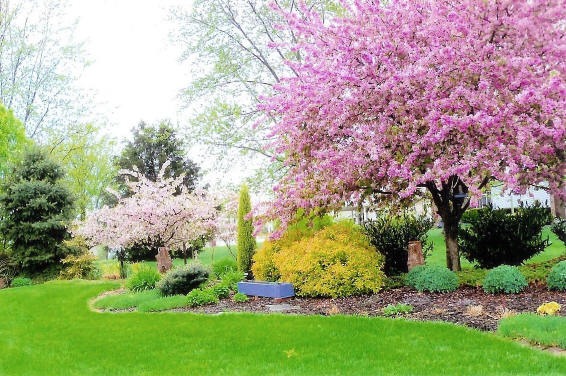|
Gardening in the Glorious Month of May
Barbara Mrgich
Adams County Master Gardener
 I sit on my front porch and inhale the beauty. The grass is emerald green, the sunrise locust has brand new bright yellow leaves which look gorgeous against the deep burgundy leaves of the Japanese maples and sand cherries. The crabapples and lilacs add a contrast of lavender and
white. The bulbs and bleeding heart are just delightful. It's just glorious! It must be May. I sit on my front porch and inhale the beauty. The grass is emerald green, the sunrise locust has brand new bright yellow leaves which look gorgeous against the deep burgundy leaves of the Japanese maples and sand cherries. The crabapples and lilacs add a contrast of lavender and
white. The bulbs and bleeding heart are just delightful. It's just glorious! It must be May.
I keep a large ornamental/perennial garden. It occupies a major portion of our property. In order to stay on top of tasks, and not fall behind, I keep a loose schedule of jobs to be completed. By May I have already cleaned up all my gardens back in March, cut down old perennials and cut back shrubs that flower on new wood. I also edged and
fertilized. In April, I transplanted and divided anything that needed it, and started to add any new plantings that I want for this season.
Now it's May, and I can totally enjoy the beauty. The biggest job on my May schedule is mulching. I'm not going to do that right now though because I want the soil to warm up sufficiently. Remember, that one very important reason to mulch is to keep the soil cool in the summer. If you are looking forward to planting annuals, you want that
soil to warm up.
Plant your annuals too early in cold soil, and they will just sit there doing nothing until a rabbit comes along to eat off their heads. It's best to wait until May 15 to plant annuals in the ground. While you are waiting, though, if you haven't already done it, plant your pots. Soil in pots is much warmer than ground soil. So go ahead and
plant them. I usually do mine by the end of April. Should we get a frost warning, either move them into the garage overnight or stick a garden stake in the center of them and throw a sheet over top to make a protective tent.
I have a large variety of bulbs which I have been enjoying from late March all through April and now into early May. As my bulbs finish flowering, I cut off the dead flower stem, but never the leaves. Cutting the leaves off prematurely will prevent the bulb from completing its photosynthesis process which allows the plant to convert the
sun's energy to necessary nutrients. In other words, the bulb will weaken and eventually disappear if you cut off its green leaves. Wait until the leaves turn brown. Planting your bulbs among later emerging perennials and groundcovers will help camouflage the withering leaves.

During April and May, you have been enjoying the blooms of all early flowering shrubs. May is the time to prune those shrubs if you want to change their height or shape. Also check for damaged or diseased wood and get rid of that. If you pay attention to your azaleas, lilacs, rhododendrons, etc., you will notice that shortly after blooming
they will start to set next year's buds. If you prune these shrubs in July, which many people do, you will get no flowers next year. Prune them shortly after they finish flowering, before they set those new buds.
Now back to the mulch. Choosing the type of mulch you use is a topic for another article. However, whatever you choose, wait until the soil is warm, then add two to four inches. Spread it carefully under your emerging perennials and newly planted annuals. The mulch will not only make your garden look beautiful, it will keep the soil cool
in the heat of summer, help retain water, prevent weeds, and add organic material to your soil. After spreading my mulch, I like to use trifluralin, which is a pre-emergent. You can easily find it in any garden center under the brand name of Preen, among others. A pre-emergent will stop seeds from germinating. It will not damage plants that are already growing. When your
neighbor's dandelion seeds blow into your garden, it will stop them from developing for up to three months. Just be sure to water it in well after applying because dry trifluralin will simply dissipate into the air. Also remember not to spread it anywhere you are counting on certain flowers to self-seed.
I think of March, April, and May as the building block months for my garden. When I have completed the tasks I mentioned in this article and finished up with the mulching, the hard work of my gardening season is over. The rest of the summer is maintenance, vigilance and pure enjoyment.
Read other articles on plants and gardens
Read other spring related gardening articles
Read other articles by Barbara Mrgich
|